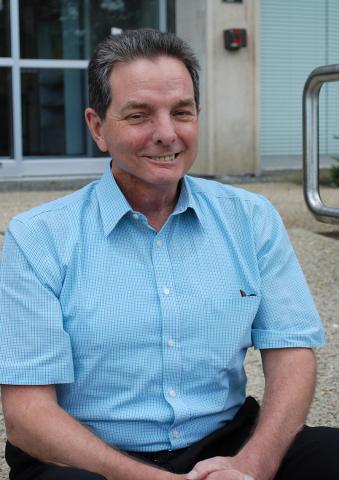Life Saved Here
OIT’s Sweeney Comes by Love of NIH Honestly

Photo: Rich McManus
Kevin Sweeney, a desktop technician with the Office of Information Technology since last March, has been associated with NIH, man and boy, for much of his life. And he is that rare NIH’er who is grateful not just for his work at a place that holds high the mission of health, but to be alive at all. Years ago, in a story fraught with serendipity, NIH saved his life.
Sweeney, now 63, was an Army brat, born on a base in Heidelberg, Germany. By the time his family moved to Wheaton in 1968, when he was 12, the family had lived—and by Kevin’s account, left a rather rambunctious mark—in New York, suburban Chicago, Columbus, Ga., and Atlanta.
“We were horrible children,” says Sweeney of his older brother, his twin brother and a younger sister and brother. “What a band of troublemakers my mother had to put up with,” he adds, recounting the time his brother pulled him out of a neighbor’s pool, to save him from drowning. And the time he dangled by the flesh of his arm from the barbs of a cyclone fence.
“My mother contemplated having a wing of the local hospital named for us, we were there so often.”
Not long after the family relocated to Montgomery County, Sweeney and his twin brother—14 minutes older than Kevin—enrolled in a twin study at NIH. He got a patient ID number and spent the summer commuting by bus to NIH for testing and interviews.
“That was my first introduction to NIH.”
Sweeney graduated from John F. Kennedy High School in Wheaton, where he had played football and wrestled, then attended Towson State University for a year before realizing that he wasn’t ready for college.
For a couple of years he worked odd jobs—sales rep at Hechinger’s, which was the Home Depot of its day in suburban D.C., and dishwasher and busboy at the legendary Capitol Hill watering hole, the Tune Inn, which was owned by a neighbor in Wheaton.
The Tune Inn has birthed many a life lesson over the decades, and Sweeney picked up at least two. There was the night after shift when he decided to ride as a passenger on the back of a customer’s Norton 750 Commando racing motorcycle. The driver popped a wheelie at 100 m.p.h. on Independence Ave., as Sweeney hung on for dear life.
Then there was the time Rep. John Anderson, then running for President, decided he would take over the Tune Inn at lunchtime for a staff meeting. The bar’s owner told Anderson and his entourage that they could wait in line like everybody else.
“At the Tune Inn, social status doesn’t mean a lot,” Sweeney observes, drily.
Such experiences convinced Sweeney of the value of an education, so in the next few years, he took courses in information systems management at Montgomery College while also working full-time in the graphics department at Vitro, a defense contractor in Aspen Hill. It took him 5 years to earn his A.A. degree.
In the summer of 1980, Sweeney married his girlfriend Brenda, whom he had met but not dated in high school. At the time of their wedding, she was a waitress at Bethesda’s famed old seafood house, O’Donnell’s, but later took a job as a letter carrier, a job that would prove strangely fortuitous.
In the fall of 1985, while participating in a corporate blood drive at Vitro, Sweeney was filling out a questionnaire that inquired about night sweats, or lumps in the throat. Indeed he had a lump near his lower right jaw that soon drew the attention of a series of doctors. A biopsy at Holy Cross Hospital probed a mass under a vein in his neck, and a sample was sent to pathologists at Walter Reed.
It took weeks, but Sweeney, then 29, learned he had synovial cell sarcoma.

Photo: Rich McManus
The news hit Brenda hard. One day, while delivering mail in Kensington, she was stopped by a customer who noticed that she was not her normal, jovial self. The customer was Dr. Lyndon Lee, a retired NIH scientist. Brenda shared her husband’s diagnosis, and soon Lee was trying to enroll him in a protocol at NIH.
“I came to NIH and I met a doctor in Bldg. 10 and told him all I’d been through,” said Sweeney. “He said, ‘Let me put it in the computer and see what happens.’ I turned out to be a good match for his study.” His old patient ID number from the twin study was still in the system and became part of his inpatient wristband.
Sweeney was given three treatment options, all of which involved surgery. “I said fine—I really had no idea what I was doing.”
He underwent surgery—a “modified right neck dissection” that ran from his jaw to his collarbone—in August 1986, with hopes of being well enough to attend a friend’s wedding in September.
“They took out muscles and nerves—anything the tumor had grown onto,” Sweeney recalls. “It took 7 hours. They made a movie of the procedure, which is still probably in the archives of NIH.”
Doctors told him his case was of special interest because of the tumor’s location—it normally isn’t found above the shoulders, preferring joints such as shoulders and knees. “That gave them a lot of drive to put me into a protocol,” Sweeney recalled.
Though post-operatively “I had a tremendous loss of ability to hold my head up,” Sweeney soon found himself involved in customary shenanigans: needing to use the bathroom one day in the ICU, he yanked out all his tubes, prompting more than a dozen caregivers to rush his room, thinking he had coded. Then there was the time his twin brother decorated Kevin’s room with toys from Toys R Us, then, toting a plastic bag filled with 1,000 plastic flies, proceeded to leave them all over the Clinical Center.
“He hit all the floors. I thought that was pretty funny.”
Sweeney soon went back to work at Vitro and was able to make that September wedding. His health scare also prompted a new seriousness about school. He enrolled at the University of Maryland University College to get his 4-year degree in computer and information sciences.
There were follow-up radiation treatments at NIH, but he scheduled them for early in the day so he could go to work.
“Everyone at NIH was very kind and very nice and very helpful,” he said. “I couldn’t have had a better experience, going through that part of it.”
His ordeal left him with limited ability to enjoy food for several months.
“Beer tasted like crap,” he remembers. “When that happens, you know you’re in trouble.”
Because of nerve removal, he was left with Horner’s syndrome, a drooping of the right eyelid.
Halfway through his course of radiation, he suffered a breakdown.
“It finally hit me one day,” he said. “Why me? Why am I going through this? I started crying while I was sitting in my car. I guess it was the release of all that pent-up pressure and tension.”
Soon, however, he snapped out of his funk when he remembered that his dad—a career military man and West Point graduate who had died of a heart attack just 5 years earlier—would want him to “stand up and march through it. From that point on, I just decided to go on.”
He had lost so much weight that an NIH doctor threatened to have him re-hospitalized and force-fed, but once radiation treatment ended, Sweeney began to mend.
“The farther away I got from radiation, it all started to come back to me—even beer.”
NIH kept him on a post-treatment plan for the next decade. Sweeney had to check in every 3 months. Thyroid medication, which he is still on, took care of an organ burned up in therapy.
He also needed speech therapy, to correct surgery-related changes in the timbre of his voice.
Thirty-three years after his operation, Sweeney considers himself well and truly cured, though he still has problems with his neck and shoulders related to muscles removed during surgery.
“My experience at NIH was tremendous,” he concludes. “The most heart-breaking thing in all those 10 years of follow-up was the trip I had to make from EKG on the first floor. I’d pass young children on their way to cancer treatment. That broke my heart, to see them go through what I did at such a young age. I’d pray for them.
“Some people get dealt a bad hand pretty early,” he continued. “Other people have to wait for it. I’m just blessed that nothing went wrong. I personally consider my wife [who recently retired after 38 years with the Postal Service] to have saved my life. She’s my hero when it comes to this.”
A believer in paying it forward, Sweeney now donates blood and plasma at the Red Cross “as payback. You’ve got to be willing to pay back society, if they did something for you.”
He even coached 8-year-old girls in softball, as part of his restitution.
“That was some tough payback,” he laughs.
“I can’t express how grateful I am for the treatment I got here,” he said. “And the cost would have been crushing. I had only been married for 5 years when it happened. Every little thing I needed, every pain, was taken care of.”
Though he owes his life to what went on there, Sweeney still finds Bldg. 10 baffling.
“I got lost in it the other day for half an hour!”
